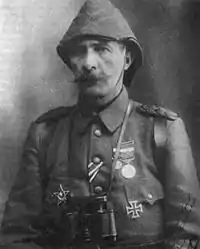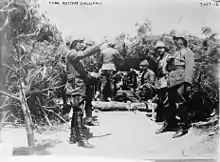Mehmet Esat Bülkat
Mehmed Esad Pasha (18 October 1862 – 2 November 1952), known as Mehmet Esat Bülkat after the 1934 Surname Law, was an Ottoman general active during the First Balkan War, where he led the Yanya Corps, and in World War I, where he was the senior Ottoman commander in the Dardanelles Campaign.
Mehmet Esat Bülkat | |
|---|---|
 Mehmed Esad Pasha in 1915 | |
| Born | 18 October 1862 Yanya, Ottoman Empire |
| Died | 2 November 1952 (aged 90) Istanbul, Turkey |
| Allegiance | |
| Service/ | |
| Years of service | 1884–1919 |
| Rank | Lieutenant general |
| Battles/wars | Greco-Turkish War of 1897 First Balkan War Gallipoli Campaign |
| Relations | Wehib Pasha |
Life

Mehmed Esad was born into an Albanian Muslim family in Yanya (now Ioannina) on October 18, 1862, the son of Mehmed Emin Efendi, who had served as mayor of the city.[1][2] According to Jacques Kayaloff, he was of Albanian origin.[1] His brother, also an Albanian Mehmed Wehib (1877–1940), also became a distinguished general.
Esad spent the first seventeen years of his life in Yanya and later attended the military school at Monastir (modern Bitola).[2] While there Esad's knowledge of Ottoman Turkish was limited and he took additional lessons to broaden his competency in the language.[2] He would reflect later in life that local Muslims of Yanya barely had any knowledge of Turkish.[2] Having polished up his skills in Ottoman Turkish[2] Esad attended the Ottoman Military Academy, graduating in 1884. After a period of service in a regiment, he was selected for the Ottoman Military College in 1887, graduating as a General Staff officer in 1890. His excellent performance led to his immediate dispatch to attend the Prussian War Academy in Berlin, from where he graduated in May 1894.[3] After a stint at the General Staff, he was promoted to Lt Colonel and given a teaching position at the War Academy. By the time the Greco-Turkish War of 1897 broke out, he had been promoted to Colonel, and he commanded a regiment during the war. In 1899, he was placed as head of training at the War Academy. In 1901 he was promoted to Mirliva (Brigadier) and to Ferik (Major General) in 1906. From 1907 he served as Chief of Staff of the Third Army at Thessaloniki.[4]
In 1911, he commanded the 5th Regular (Redif) Division at Gallipoli for a short period before returning to Yanya to command the 23rd Regular Division. It was at this post that the outbreak of the First Balkan War found him.[2] Esat was immediately detached from divisional command and placed in charge of the provisional Yanya Corps, tasked with defending the well-fortified city and the wider region of Epirus. Esad succeeded in defending Yanya for several months against the Greek Army, but was finally forced to capitulate after the Battle of Bizani on 4–6 March 1913.[4][2]
Esat remained in Greek captivity as a prisoner of war until 2 December 1913. His defence of Yanya however had earned him the status of a popular hero, as well as the honorific title of "Pasha". Almost immediately upon his return, on 10 December, he was appointed commander of the III Corps at Gallipoli, which he would lead into battle during the Gallipoli Campaign.[3] The III Corps quickly established itself as one of the most combat-worthy formations in the Ottoman army, as most of its units and soldiers had recent fighting experience from the Balkan Wars. It is indicative that when the Ottoman Army mobilized upon its entry in World War I, Esad's corps was the only one to do so within the prescribed timeframe.[3]
Although most accounts of the Battle of Gallipoli tend to focus on the role of Fifth Army's commander, German general Liman von Sanders, and on Mehmed Esad's subordinate, Mustafa Kemal Pasha (better known as Atatürk, the founder of modern Turkey),[5] it was Mehmed Esad who prepared the Ottoman defences during the battle, and who actively commanded the Ottoman army in the Gallipoli peninsula during the battle.[6][2] In October 1915, Esad was appointed as CO of First Army, succeeding Colmar Freiherr von der Goltz, who was dispatched to the Mesopotamian front. In late 1917, Esad visited Germany and toured the German fronts. In February 1918 he was placed in command of the Fifth Army, and in June, of the Third Army on the Caucasus front. After the Armistice of Mudros, and until his retirement on 22 November 1919, he served as Inspector-General of the mostly demobilized Second Army.
In 1920, Esad Pasha served as Navy Minister in the short-lived cabinet of Hulusi Salih Pasha. In 1934, due to the Surname Law he adopted the name "Bülkat". He died in Istanbul in 1952. A selection of his memories was published in 1975 [7] under the title Esat Paşa'nın Çanakkale Anıları (Esat Pasha's Çanakkale Memoirs).
References
- Kayaloff p.14
- Gawrych, George (2006). The Crescent and the Eagle: Ottoman rule, Islam and the Albanians, 1874–1913. London: IB Tauris. p. 26. ISBN 9781845112875.
- Erickson (2007), pp. 51–52
- Erickson (2007), p. 52
- Erickson (2007), pp. 28, 51
- cf. Erickson (2007), pp. 53–54
- "ESAT PASHA (1862–1952)". www.canakkale.gen.tr.
Sources
- Erickson, Edward J. (2007). Ottoman Army effectiveness in World War I: a comparative study. Taylor & Francis. ISBN 978-0-415-77099-6.
- Kayallof, Jacques (1973). The battle of Sardarabad. Mouton. p. 14. Retrieved 18 October 2011.